Citroen DS5 HYBRID4 2013 1.G Service Manual
Manufacturer: CITROEN, Model Year: 2013, Model line: DS5 HYBRID4, Model: Citroen DS5 HYBRID4 2013 1.GPages: 364, PDF Size: 10.21 MB
Page 41 of 364

39Hybrid system
Zone which indicates an increased cumulative power demand
from your hybrid vehicle,
taking account of the combined power availablefrom the Diesel engine and the electric motor.
POWER zone
Page 42 of 364
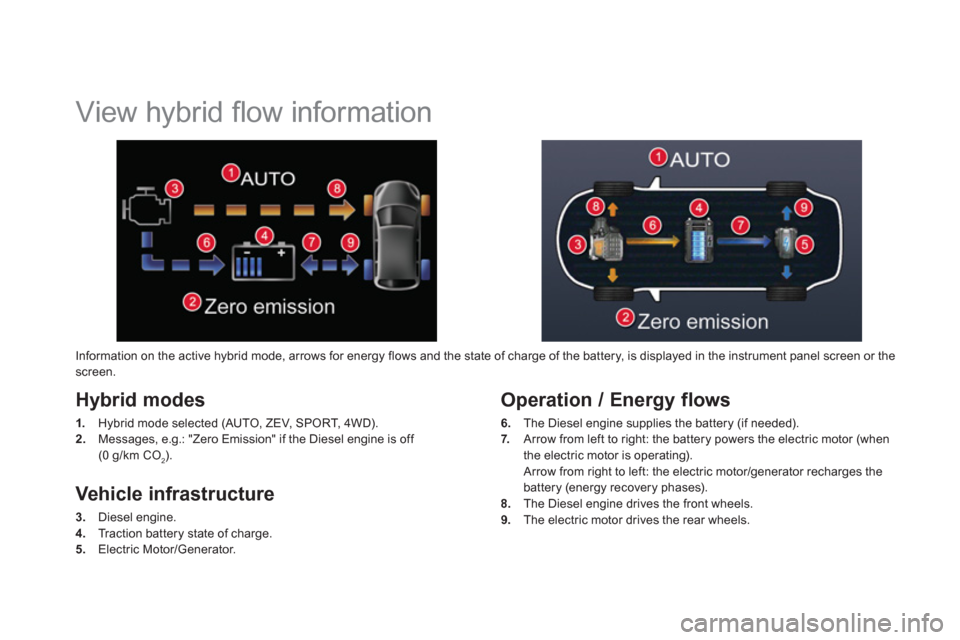
View hybrid fl ow information
Hybrid modes
1.
Hybrid mode selected (AUTO, ZEV, SPORT, 4WD).
2.
Messages, e.g.: "Zero Emission" if the Diesel engine is off (0 g/km CO2).
Operation / Energy flows
6.
The Diesel engine supplies the battery (if needed).
7.Arrow from left to right: the battery powers the electric motor (when
the electric motor is operating).
Arrow from right to left: the electric motor/generator recharges the
battery (energy recovery phases).8. The Diesel engine drives the front wheels. 9.The electric motor drives the rear wheels.
Vehicle infrastructure
3.
Diesel engine.4.
Tr a c t i o n b a t t e ry state of charge. 5.
Electric Motor/Generator. Information on the active h
ybrid mode, arrows for energy flows and the state of charge of the battery, is displayed in the instrument panel screen or the screen.
Page 43 of 364
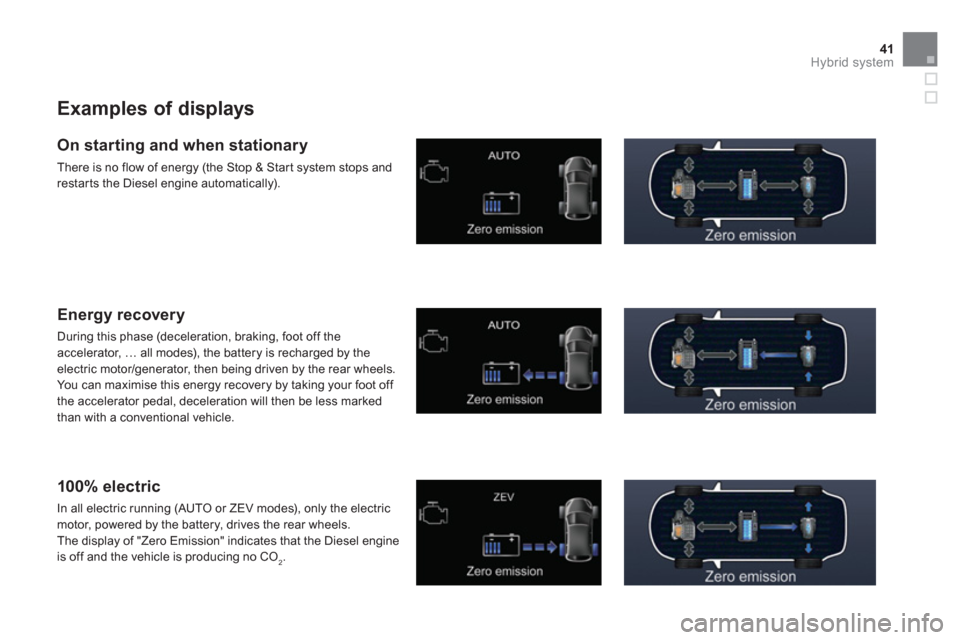
41Hybrid system
Examples of displays
On starting and when stationary
There is no flow of energy (the Stop & Star t system stops and
restar ts the Diesel engine automatically).
Energy recovery
During this phase (deceleration, braking, foot off the
accelerator, … all modes), the battery is recharged by the electric motor/generator, then being driven by the rear wheels.
You can maximise this energy recovery by taking your foot off
the accelerator pedal, deceleration will then be less marked
th
an with a conventional vehicle.
100% electric
In all electric running (AUTO or ZEV modes), only the electric motor, powered by the battery, drives the rear wheels.
The display of "Zero Emission" indicates that the Diesel engine
is off and the vehicle is producing no CO2.
Page 44 of 364

Automatic restarting of the Diesel engine or ZEV mode NOT available
Maintaining the performance
of the system
- When the vehicle exceeds 18 mph(30 km/h) after moving off (if the internal
combustion engine has not already star ted since the vehicle was last star ted).
- If the high voltage battery is not sufficiently charged. A minimum of 4 barsin ZEV mode so as to ensure operationover a cer tain distance (in AUTO, electricoperation is accessible for a shor ter period with a lower level of charge).
- When the fuel level enters the reservezone (where rate of consumption of this reser ve is high, ZEV inhibition may continue for some time after refuelling).
- During regeneration of the particleemissions filter, which occursautomatically for 5 to 10 minutes,approximately every 300 miles (500 kms)(or less in extended urban running).
The internal combustion engine may restar t or
ZEV mode may not be available in the variousconditions presented below. The internal combustion engine can beswitched off automatically as soon as these
conditions are lifted. When the conditions described below causethe vehicle to come out of ZEV mode andthe Diesel engine to restar t, the vehicle automatically changes to AUTO mode.
Your vehicle is fitted with the most effective emissions control systems, in par ticular the Particle Emissions Filter (PEF).
At regular inter vals your Diesel engine will produce energy for the self-cleaning of this filter.During this PEF regeneration phase, electric running is purposely made unavailable andis accompanied by a message "Electricmode not available: PEF regeneration inprogress
".
Action by the driver
- Moving the gear selector to position M
. - Action on steering mounted control paddles to change gear.- Sustained and sharp acceleration. - Use of demisting.- Use of air conditioning.
Diffi cult weather conditions and
circumstances
- If cer tain conditions or engine temperature requirements make it necessary (such as an engine temperature that is too low for the ambient conditions).
- When the battery is close to maximumcharge (for example: when going down a long hill), because engine recoverybeing no longer possible, the internalcombustion engine restar ts automatically just to provide engine braking.
- If the vehicle encounters a steep slope(car park ramp, ...).
- If the vehicle has been parked in the sunfor a prolonged period.
- When driving in mountainous conditions(altitude).
Page 45 of 364
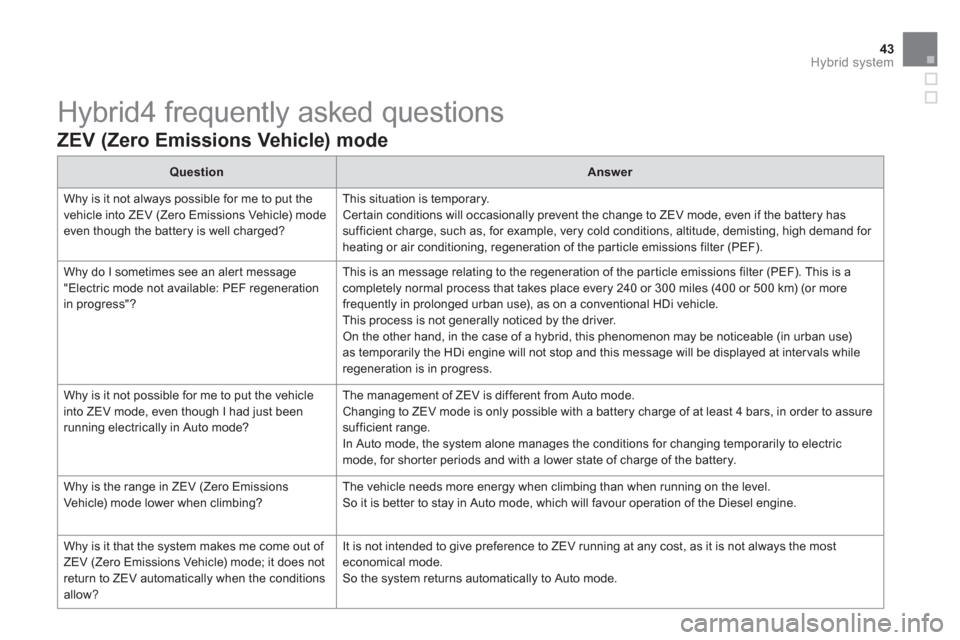
43Hybrid system
Hybrid4 frequently asked questions
ZEV (Zero Emissions Vehicle) mode
QuestionAnswer
Why is it not always possible
for me to put the
vehicle into ZEV (Zero Emissions Vehicle) mode even though the battery is well charged? This situation is temporary.
Certain conditions will occasionally prevent the change to ZEV mode, even if the battery hassufficient charge, such as, for example, very cold conditions, altitude, demisting, high demand for heating or air conditioning, regeneration of the par ticle emissions filter (PEF).
Wh
y do I sometimes see an aler t message "Electric mode not available: PEF regeneration
in progress"? This is an messa
ge relating to the regeneration of the par ticle emissions filter (PEF). This is acompletely normal process that takes place every 240 or 300 miles (400 or 500 km) (or more
frequently in prolonged urban use), as on a conventional HDi vehicle.
This process is not generally noticed by the driver.
On the other hand, in the case of a hybrid, this phenomenon may be noticeable (in urban use)
as temporarily the HDi engine will not stop and this message will be displayed at intervals while
regeneration is in progress.
Wh
y is it not possible for me to put the vehicle
into ZEV mode, even though I had just beenrunning electrically in Auto mode? The mana
gement of ZEV is different from Auto mode.
Changing to ZEV mode is only possible with a battery charge of at least 4 bars, in order to assure sufficient range.
In Auto mode, the system alone manages the conditions for changing temporarily to electric mode, for shorter periods and with a lower state of charge of the battery.
Wh
y is the range in ZEV (Zero Emissions
Vehic le) mode lower when climbing? The vehicle needs more energy when climbing than when running on the level.
So it is better to stay in Auto mode, which will favour operation of the Diesel engine.
Why is it that the system makes me come out o
f
ZEV (Zero Emissions Vehicle) mode; it does notreturn to ZEV automatically when the conditions allow? It is not intended to give pre
ference to ZEV running at any cost, as it is not always the most economical mode.
So the system returns automatically to Auto mode.
Page 46 of 364
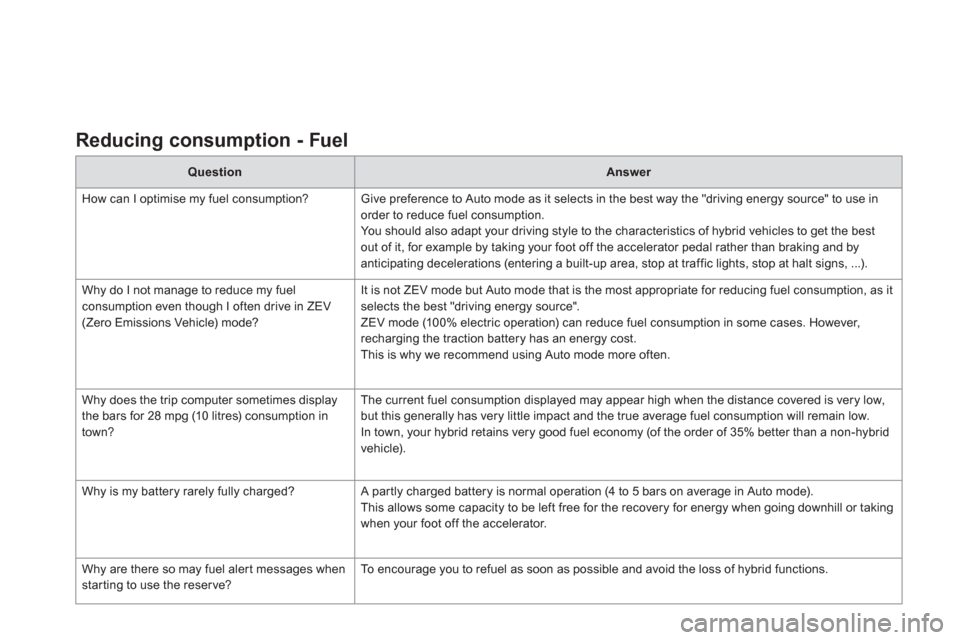
Reducing consumption - Fuel
QuestionAnswer
How can I optimise m
y fuel consumption? Give preference to Auto mode as it selects in the best way the "driving energy source" to use in
order to reduce fuel consumption.
You should also adapt
your driving style to the characteristics of hybrid vehicles to get the best
out of it, for example by taking your foot off the accelerator pedal rather than braking and by
anticipating decelerations (entering a built-up area, stop at traffic lights, stop at halt signs, ...).
Wh
y do I not manage to reduce my fuel consumption even though I often drive in ZEV(Zero Emissions Vehicle) mode?It is not ZEV mode but Auto mode that is the most appropriate
for reducing fuel consumption, as it selects the best "driving energy source".
ZEV mode (10 0% electric operation) can reduce fuel consumption in some cases. However,
recharging the traction battery has an energy cost.
This is why we recommend using Auto mode more often.
Wh
y does the trip computer sometimes displaythe bars for 28 mpg (10 litres) consumption in
town? The current fuel consumption displa
yed may appear high when the distance covered is very low,
but this generally has very little impact and the true average fuel consumption will remain low.
In town, your hybrid retains very good fuel economy (of the order of 35% better than a non-hybrid
vehicle).
Wh
y is my battery rarely fully charged? A partly charged battery is normal operation (4 to 5 bars on average in Auto mode).
This allows some capacity to be left free for the recovery for energy when going downhill or takingwhen your foot off the accelerator.
Wh
y are there so may fuel aler t messages whenstarting to use the reser ve?To e n c o u r age you to refuel as soon as possible and avoid the loss of hybrid functions.
Page 47 of 364
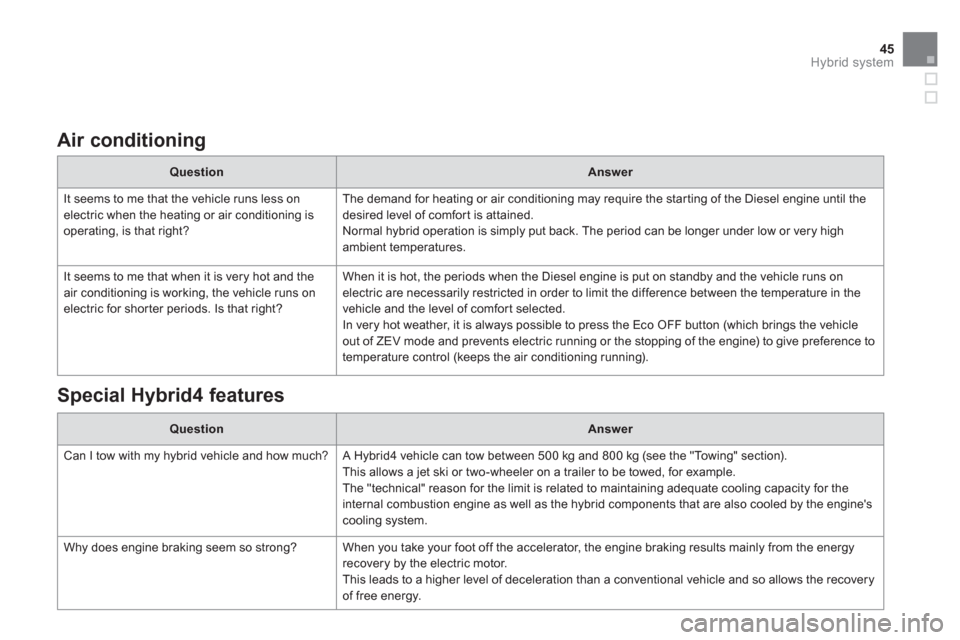
45
Hybrid system
Air conditioning
QuestionAnswer
It seems to me that the vehicle runs less on electric when the heating or air conditioning is
operatin
g, is that right?
The demand for heating or air conditioning may require the star ting of the Diesel engine until thedesired level of comfort is attained.
Normal h
ybrid operation is simply put back. The period can be longer under low or very high
ambient temperatures.
It seems to me that when it is ver
y hot and the
air conditioning is working, the vehicle runs on electric for shor ter periods. Is that right? When it is hot, the periods when the Diesel en
gine is put on standby and the vehicle runs onelectric are necessarily restricted in order to limit the difference between the temperature in the
vehicle and the level of comfort selected.
In very hot weather, it is always possible to press the Eco OFF button (which brings the vehicle out of ZEV mode and prevents electric running or the stopping of the engine) to give preference to
temperature control (keeps the air conditioning running).
Special Hybrid4 features
QuestionAnswer
Can I tow with m
y hybrid vehicle and how much? A Hybrid4 vehicle can tow between 500 kg and 800 kg (see the "Towing" section).
This allows a jet ski or two-wheeler on a trailer to be towed, for example.
The "technical" reason for the limit is related to maintaining adequate cooling capacity for the internal combustion engine as well as the hybrid components that are also cooled by the engine's cooling system.
Wh
y does engine braking seem so strong? When you take your foot off the accelerator, the engine braking results mainly from the energyrecovery by the electric motor.
This leads to a higher level of deceleration than a conventional vehicle and so allows the recoveryof free energy.
Page 48 of 364
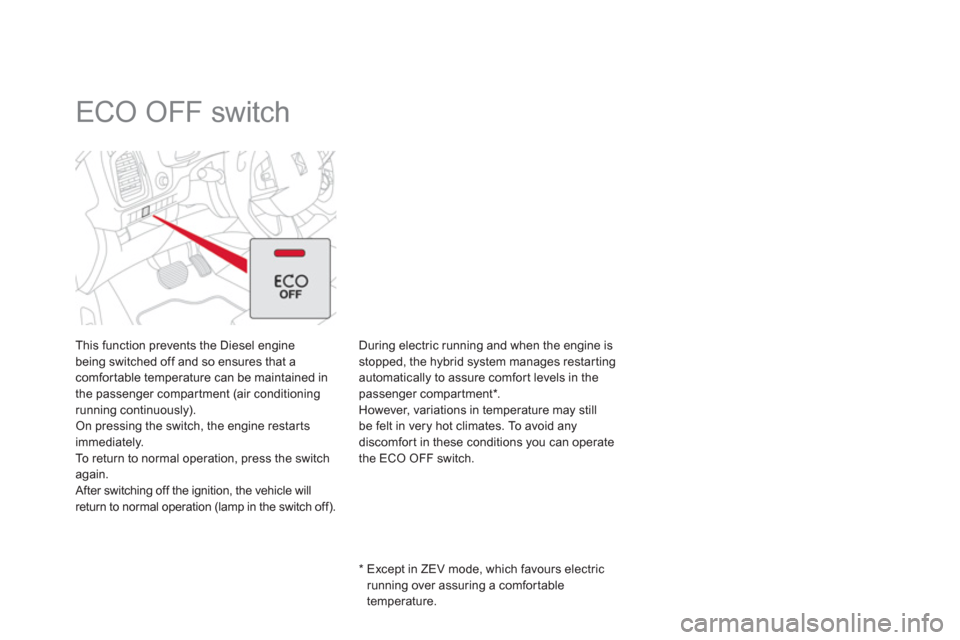
ECO OFF switch
This function prevents the Diesel engine
being switched off and so ensures that a comfor table temperature can be maintained in
the passenger compar tment (air conditioningrunning continuously).On pressing the switch, the engine restar ts
immediately.
To return to normal operation, press the switch
again.
After switching off the ignition, the vehicle will return to normal operation (lamp in the switch off).
*
Except in ZEV mode, which favours electric
running over assuring a comfortable
temperature.
During electric running and when the engine is
stopped, the hybrid system manages restarting
automatically to assure comfor t levels in the
passenger compartment * .
However, variations in temperature may still be felt in very hot climates. To avoid anydiscomfor t in these conditions you can operate
the ECO OFF switch.
Page 49 of 364
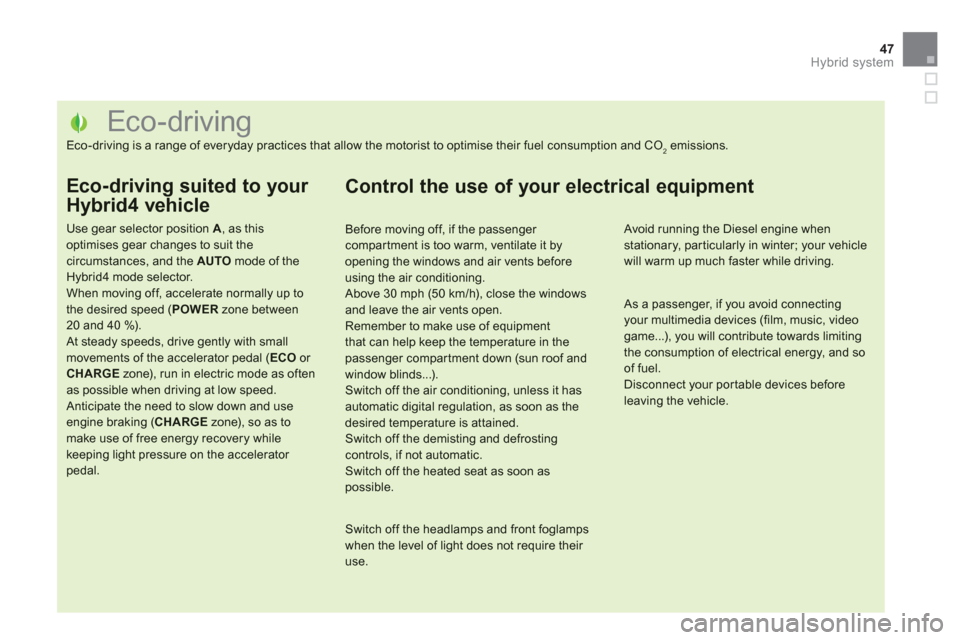
47Hybrid system
Eco-driving
Eco-driving is a range of everyday practices that allow the motorist to optimise their fuel consumption and CO2 emissions.
Eco-driving suited to your
Hybrid4 vehicle
Use gear selector position A , as thisoptimises gear changes to suit the circumstances, and the AUTOmode of theHybrid4 mode selector.When moving off, accelerate normally up tothe desired speed ( POWER
zone between20 and 40 %). At steady speeds, drive gently with smallmovements of the accelerator pedal (ECOor CHARGEzone), run in electric mode as oftenas possible when driving at low speed. Anticipate the need to slow down and useengine braking ( CHARGE
zone), so as to make use of free energy recovery while keeping light pressure on the accelerator pedal.
Before moving off, if the passenger compartment is too warm, ventilate it byopening the windows and air vents beforeusing the air conditioning.
Above 30 mph (50 km/h), close the windowsand leave the air vents open. Remember to make use of equipment that can help keep the temperature in the passenger compar tment down (sun roof andwindow blinds...).Switch off the air conditioning, unless it has automatic digital regulation, as soon as the desired temperature is attained.Switch off the demisting and defrostingcontrols, if not automatic.Switch off the heated seat as soon as possible.
Switch off the headlamps and front foglampswhen the level of light does not require their use.
Avoid running the Diesel engine when stationary, par ticularly in winter; your vehiclewill warm up much faster while driving.
As a passenger, if you avoid connecting your multimedia devices (film, music, video game...), you will contribute towards limitingthe consumption of electrical energy, and soof fuel.
Disconnect your por table devices beforeleaving the vehicle.
Control the use of your electrical equipment
Page 50 of 364
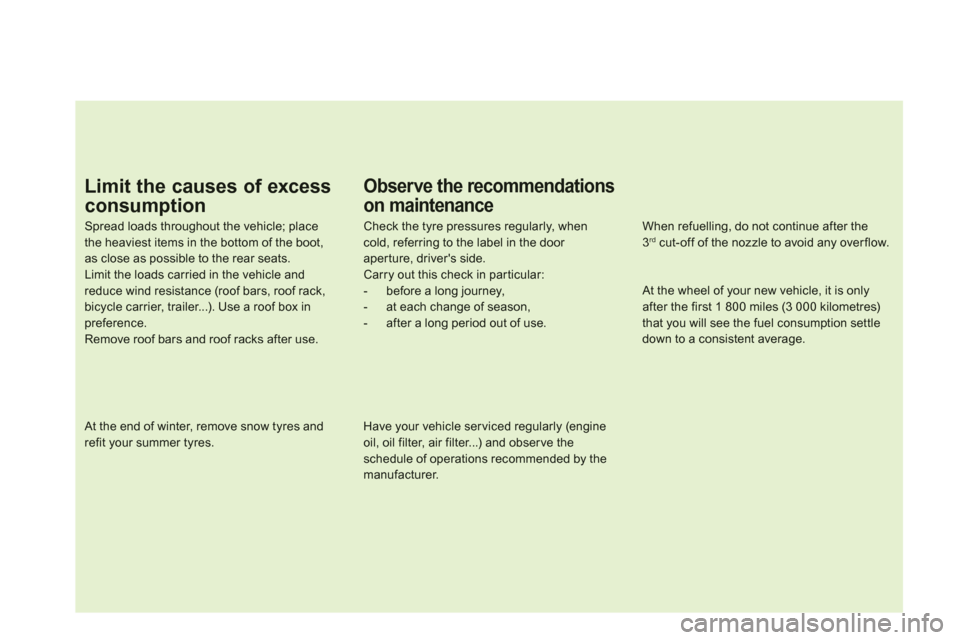
Observe the recommendations
on maintenance
Check the tyre pressures regularly, whencold, referring to the label in the door aperture, driver's side.
Carry out this check in par ticular:
- before a long journey,
- at each change of season,
- after a long period out of use.
Have your vehicle ser viced regularly (engine oil, oil filter, air filter...) and obser ve the schedule of operations recommended by themanufacturer.
When refuelling, do not continue after the3 rd
cut-off of the nozzle to avoid any over flow.
At the wheel of your new vehicle, it is onlyafter the first 1 800 miles (3 000 kilometres) that you will see the fuel consumption settle down to a consistent average.
At the end of winter, remove snow tyres and refit your summer tyres.
Spread loads throughout the vehicle; placethe heaviest items in the bottom of the boot,as close as possible to the rear seats.Limit the loads carried in the vehicle andreduce wind resistance (roof bars, roof rack,bicycle carrier, trailer...). Use a roof box in preference.Remove roof bars and roof racks after use.
Limit the causes of excess
consumption